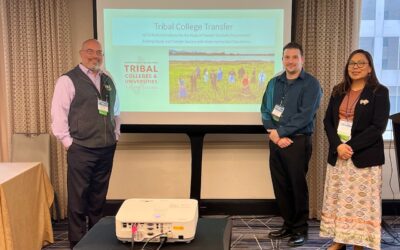By helping American Indians go to college, the American Indian College Fund (the Fund) not only helps older American Indians, but it is also helping American Indian children.
Consider the facts: the average tribal college student is a 27-year-old single mother of three, and is often the first in her family to attend college. By ensuring that these young mothers attend college, they are assured of greater earning potential, helping them to better support their children and to give them better lives.
Traditionally American Indian people were suspicious of education, and with good reason. U.S. government policy beginning in the early 1900s and continuing on until the middle of the century focused on assimilation. As part of that policy, young children were removed from their families and forced to abandon their languages, religious practices, and culture. Children were often beaten for speaking their Native languages, and many suffered physical and sexual abuse. The education curriculum itself was designed to prepare Indian people for lives as domestic and farm help, and to separate them from their traditions.
Today things have changed, thanks to the establishment of the first-ever tribal college and university in 1968 by the Navajo nation. The Navajo people wanted to establish a college by and for the Navajo people that would educate their people in new technology and other important subjects, while preserving the Navajo language and culture. Today there are 32 accredited tribal colleges and universities across the country serving the more than 200 federally recognized American Indian tribes. As a result of the tribal college movement, American Indians have embraced education, and over the past 25 years the number of associate’s, bachelors, and masters degrees conferred to Native students has doubled. The numbers in recent years continues to grow. Enrollment of American Indian students at tribal colleges grew by 32% between 1997-2002, compared to 16% enrollment growth in higher education overall, according to the American Indian Higher Education Consortium.
The American Indian College Fund is proud to be part of the tribal college movement. The Fund was established 20 years ago to provide Native students, still the poorest in the nation, according to the U.S. Census Bureau, with scholarships. Today still 95% percent of tribal college students demonstrate financial need. Yet as the number of educated Native peoples increases, more people find jobs and hope for a better future.
The Fund helps provide its students with a better future—and is changing the face of Indian Country for generations to come. Educated American Indians serve as role models in their communities for the next generation, helping youth to steer clear of drugs, alcohol, and gangs, and to dream of a better and more productive future for themselves. Research shows that in the past 20 years, the number of American Indian tenth graders who expect to complete a college degree has more than doubled to 76%.
The Fund provides a means for Native people to rebuild their communities. Despite up to 85% unemployment rates on reservations where tribal colleges are located, one year after graduating, 82% of tribal college students are working or pursuing a higher degree, 64% of tribal college students continue their education, and more than 50% pursue a higher degree. Sixty four percent of our scholarship recipients are planning to use their education to help their people.
In these economic times, when there is talk of rebuilding the nation, we cannot give up on our efforts to rebuild Indian Country–and build a prosperous future for American Indian children for generations to come.






